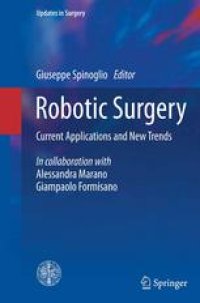
Ebook: Robotic Surgery: Current Applications and New Trends
Author: Giuseppe Spinoglio (eds.)
- Tags: General Surgery, Minimally Invasive Surgery, Thoracic Surgery, Surgical Oncology, Abdominal Surgery, Imaging / Radiology
- Series: Updates in Surgery
- Year: 2015
- Publisher: Springer-Verlag Mailand
- Edition: 1
- Language: English
- pdf
This book describes the current applications of the robotic system in general surgery, focusing on the technical aspects of the procedures most commonly performed by this means. It provides a comprehensive overview of the state of the art in robotic surgery and presents the most recently available evidence as documented in the literature. The opening chapters review robotic platforms, discuss the general advantages, limitations, and strategies of robotic surgery, and identify challenges and critical elements when setting up a robotic program. The full range of applications of the robotic system is then covered, encompassing thoracic, esophageal, gastric, hepatobiliopancreatic, splenic, colorectal, endocrine, and transplantation surgery. Detailed attention is also paid to innovative applications and future trends in the robotic platform, with inclusion of a special chapter on fluorescence imaging during robotic procedures. The book closes by considering aspects related to credentialing and privileging, such as mentoring, proctoring, and teaching modules for residents and fellows. Against the background of increasing acceptance of the robotic surgery system across the globe, this book will be invaluable for all general surgeons. There is no doubt that within general surgery the system will continue to flourish on account of its undoubted technical advantages, which minimize most of the intrinsic shortcomings of laparoscopy.
This book describes the current applications of the robotic system in general surgery, focusing on the technical aspects of the procedures most commonly performed by this means. It provides a comprehensive overview of the state of the art in robotic surgery and presents the most recently available evidence as documented in the literature.
The opening chapters review robotic platforms, discuss the general advantages, limitations, and strategies of robotic surgery, and identify challenges and critical elements when setting up a robotic program. The full range of applications of the robotic system is then covered, encompassing thoracic, esophageal, gastric, hepatobiliopancreatic, splenic, colorectal, endocrine, and transplantation surgery. Detailed attention is also paid to innovative applications and future trends in the robotic platform, with inclusion of a special chapter on fluorescence imaging during robotic procedures. The book closes by considering aspects related to credentialing and privileging, such as mentoring, proctoring, and teaching modules for residents and fellows.
Against the background of increasing acceptance of the robotic surgery system across the globe, this book will be invaluable for all general surgeons. There is no doubt that within general surgery the system will continue to flourish on account of its undoubted technical advantages, which minimize most of the intrinsic shortcomings of laparoscopy.